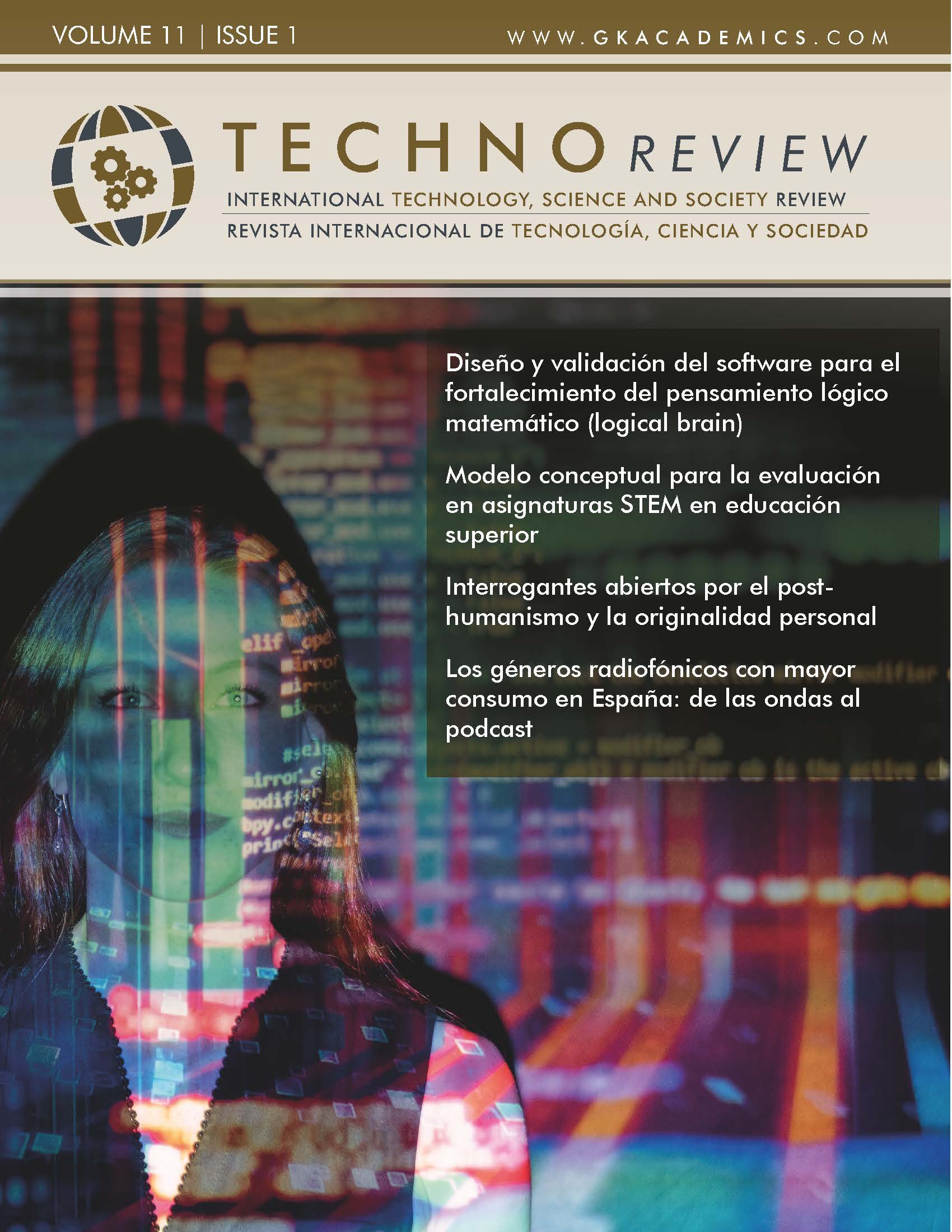Methodological Principles of Interdisciplinary Research
The Integrated Study of the Image in Social Networks
DOI:
https://doi.org/10.37467/gkarevtechno.v11.3097Keywords:
Interdisciplinary studies, Communication, Research, Social media, ImageAbstract
This text examines the basic methodological principles of interdisciplinary studies to discuss disciplinary scientific collaboration strategies around the integrated study of the image. It explores three specific areas of research: the principle of definition of the specialized positioning of interdisciplinary research and its pertinence with image study scenarios; the principle of disciplinary integration, and the use of sociodemographic variables in the study of online media and social networks and the principle of conflict reconciliation applied to the comprehensive study of the image on Instagram, Facebook and Twitter.
References
Assaker, G., O’Connor, P., & El-Haddad, R. (2020). Examining an Integrated Model of Green Image, Perceived Quality, Satisfaction, Trust, and Loyalty in Upscale Hotels. Journal of Hospitality Marketing & Management, 29(8), 934-955. https://doi.org/10.1080/19368623.2020.1751371
Bilgin, Y. (2018). The Effect of Social Media Marketing Activities on Brand Awareness, Brand Image and Brand Loyalty. Business & Management Studies: An International Journal, 6(1), 128-148. https://doi.org/10.15295/bmij.v6i1.229
Chintagunta, P., Gopinath, S., & Venkataraman, S. (2010). The Effects of Online User Reviews on Movie Box Office Performance: Accounting for Sequential Rollout and Aggregation across Local Markets. Marketing Science, 29(5), 944-957. En, https://doi.org/10.1287/mksc.1100.0572
Craig, R. (2015). The Constitutive Metamodel: a 16-year Review. Communication Theory, 25(4), 356-374. https://doi.org/10.1111/comt.12076
DataReportal (2021). Digital 2021 July Global Statshot Full Report. https://datareportal.com/reports/digital-2021-july-global-statshot
Durham, M., & Kellner, D. (Eds.). (2012). Media and Cultural Studies: Keyworks (2a ed.). John Wiley & Sons.
Huber, M., Hutchings, P., & Gale, R. (2005). Integrative Learning for Liberal Education. Peer Review, 7(4), 4–7.
Hogue, J. V., & Mills, J. S. (2019). The Effects of Active Social Media Engagement with Peers on Body Image in Young Women. Body Image, 28, 1-5. https://doi.org/10.1016/j.bodyim.2018.11.002
Huang, J., Obracht-Prondzynska, H., Kamrowska-Zaluska, D., Sun, Y., & Li, L. (2021). The Image of the City on Social Media: a Comparative Study Using “Big Data” and “Small Data” Methods in the Tri-City Region in Poland. Landscape and Urban Planning, 206, 103977. https://doi.org/10.1016/j.landurbplan.2020.103977
Huber, M. T., Hutchings, P., & Gale, R. (2005). Integrative Learning for Liberal Education. Peer Review, 7/4, 4-7.
Klein, J. T., & Newell, W. H. (1997). Advancing Interdisciplinary Studies. En J. G. Gaff, Ratcliff, & Associates (Eds.), Handbook of the Undergraduate Curriculum: a Comprehensive Guide to Purposes, Structures, Practices, and Change (pp. 393–415). Jossey-Bass.
León Duarte, G. A. (2002). Teorías e investigación de la comunicación en América Latina. Situación actual. Ámbitos. Revista Internacional de Comunicación, 7-8, 19-47. https://revistascientificas.us.es/index.php/Ambitos/article/view/9464/8241
León Duarte, G. A. (2015). Transformaciones en el campo de estudios de la Comunicación en América Latina. Perspectivas epistemológicas y éticas en torno a la generación, la apropiación y la divulgación del conocimiento [Conferencia magistral]. XV Encuentro Latinoamericano de Facultades de Comunicación Social, FELAFACS 2015. Medellín, Colombia, 5-7 de octubre de 2015.
León Duarte, G. A. (2019). Aportes teóricos a la investigación del campo periodístico. Sentidos y significados desde el Campo Intelectual Creador. Intercom: Revista Brasileira de Ciências da Comunicação, 42(3), 41-59. https://doi.org/10.1590/1809-5844201932.
León Duarte, G. A. (2021). Teorías de rango medio en comunicación: elementos constitutivos para un enfoque de comunicación como cultura. MATRIZes, 15(2), 95-118. https://doi.org/10.11606/issn.1982-8160.v15i2p95-118
León Duarte, G. A. (2022). La crítica esencialista en los estudios interdisciplinares en EUA: Sobre el proceso de integración de un terreno común interdisciplinar. Norteamérica, CISAN-UNAM, 17(1), 23. https://doi.org/10.22201/cisan.24487228e.2022.1
Levy, P. (2007). Cibercultura. Informe al Consejo de Europa. Anthropos Editorial.
Li, Y., & Xie, Y. (2020). Is a Picture Worth a Thousand Words? An Empirical Study of Image Content and Social Media Engagement. Journal of Marketing Research, 57(1), 1-19. https://doi.org/10.1177/0022243719881113
Mansilla, V. B., & Gardner, H. (2003). Assessing Interdisciplinary Work at the Frontier: an Empirical Exploration of Symptoms of Quality. Interdisciplinary Studies Project, Project Zero. Harvard Graduate School of Education publications. http://www.interdisciplinarystudiespz.org/pdf/VBM-Gardner_AssessingSymptoms_2003.pdf
Mayville, W. (1978). Interdisciplinarity: The Mutable Paradigm. The Association of American Colleges and Universities.
Martin, R., Thomas, G., Charles, K., Epitropaki, O., & McNamara, R. (2005). The Role of Leader-member Exchanges in Mediating the Relationship between Locus of Control and Work Reactions. Journal of Occupational and Organizational Psychology, 78, 141–147. DOI:10.1348/096317904X23763
National Academy of Sciences, National Academy of Engineering, & Institute of Medicine (2005). Facilitating interdisciplinary research. Department of Education.
Newell, W. (2001). A Theory of Interdisciplinary Studies. Issues in Integrative Studies, 19, 1–25. http://hdl.handle.net/10323/4378
Newell, W. H. (2007). Decision Making in Interdisciplinary Studies. En, G. Morçöl (Ed.). Handbook of Decision Making (pp. 245–264). Routledge.
Pan, X., Rasouli, S., & Timmermans, H. (2021). Investigating Tourist Destination Choice: Effect of Destination Image from Social Network Members. Tourism Management, 83, 104217. https://doi.org/10.1016/j.tourman.2020.104217
Repko, A. (2008). Interdisciplinary Research: Process and Theory. Sage.
Repko, A., Szostak, R. & Buchberger, M. (2019). Introduction to Interdisciplinary Studies. Sage Publications. https://lccn.loc.gov/2016023303
Szostak, R. (2012). Toward a Classification of Relationships. KO, Knowledge Organization, 39(2), 83-94. doi.org/10.5771/0943-7444-2012-2-83
Tan, C., Lee, L., & Pang, B. (2014). The Effect of Wording on Message Propagation: Topic-and Author-Controlled Natural Experiments on Twitter. arXiv, 1405.1438. Cornell University, https://arxiv.org/abs/1405.1438v1
Vega, L., Mendez-Vazquez, A., & López-Cuevas, A. (2021). Probabilistic Reasoning System for Social Influence Analysis in Online Social Networks. Social Network Analysis and Mining, 11(1), 1-20. https://doi.org/10.1007/s13278-020-00705-z
Welch, J. (2011). The Emergence of Interdisciplinarity from Epistemological Thought. Issues in Integrative Studies, 29(1),1-39. http://hdl.handle.net/10323/4462
Downloads
Published
How to Cite
Issue
Section
License
Those authors who publish in this journal accept the following terms:
- Authors will keep the moral right of the work and they will transfer the commercial rights.
- After 1 year from publication, the work shall thereafter be open access online on our website, but will retain copyright.
- In the event that the authors wish to assign an Creative Commons (CC) license, they may request it by writing to publishing@eagora.org







